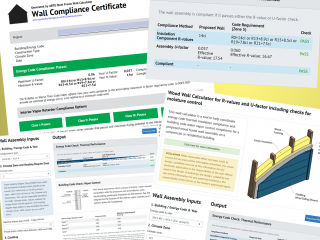Calculators for Steel and Wood Frame Wall Design
A tool to simplify wall design for thermal and moisture control
The American Chemistry Council’s Foam Sheathing Committee (FSC) focuses on developing research that supports the reliable design and installation of foam plastic insulating sheathing (FPIS) continuous insulation (ci). Pushing7 built the continousinsulation.org website with support from FSC to provide tools and resources for building designer support, code compliance, construction details, continuing education, installer support, and product research.

When members of the Foam Sheathing Committee (FSC) asked for a wall design calculator, Pushing7 delivered. Manufacturers of foam plastic insulating sheathing (FPIS) products wanted a tool to provide design professionals with a simple interface to enter information about a wall assembly to see if it complies with applicable building and energy codes without needing to page through and cross-reference several lengthy documents. Along these lines, it was also important for building designers to have the ability to easily change the wall assembly inputs on the fly to improve the design and help achieve the greatest cost savings for their project. This tool also provides a PDF output users can use to capture their wall assembly and easily share compliance certificates with others.
In the end, members liked the tool so much that some requested that we create custom versions for their companies to embed as tools on their websites.
Challenges & Requirements
-
The calculator application needed to check for energy code compliance against more than ten different building codes and standards applicable to commercial and residential construction.
-
In addition to code compliance, the calculator needed to expose results related to to moisture and vapor control compliance. This helps users understand which classes of interior vapor retardant are compatible with the proposed wall assembly.
-
Another goal for the calculator application was to make information available to users about the specific sections of the code(s) used for the calculations without introducing any unnecessary information to the user interface.
-
Providing downloadable PDFs with compliance results for users was another important requirement. These files can be can be downloaded and shared or included as documentation on code compliance to building officials and reviewers based on the products and configuration options chosen.
Solutions
-
We chose Angular for this project because it makes it possible to instantly update calculations and directly manipulate the report output, providing instant feedback to users regarding how changes to various aspects of their build affect code compliance and allowing them to make adjustments as needed.
-
The dynamic nature of the user interface allows users to explore options for building code compliance and work to exceed the standards if they want to, but also to understand exactly what will and will not work. Some questions we help builders and specifiers answer with the calculator include:
- What do I need to do to meet or exceed the building code in my area?
- How does the exterior cladding impact compliance with energy code in different areas?
- How does stud size and spacing impact energy efficiency?
- What types of interior vapor barriers (if any) are needed based on selected exterior insulation.
-
The calculator includes detailed illustrations to highlight different parts of a wall assembly, clear instructions for users working to complete the form, detailed references to relevant code, and recommendations that help users choose the best possible combination of materials for their project.
-
Downloadable reports clearly identify the status of a given wall's code compliance is and details about what type of interior vapor retarder can be used. In cases where code compliance is exceeded, reports show the percentage better than code that your wall is. Additional information about the calculations including references to the research and sources used to determine the results are also available as part of the reports.
Outcomes
After the calculators launched, a few of our clients approached us about whether it would be possible to create a customized version of the tool that includes specific R-values for their products. The idea was to replace generic form inputs that require users to look up and enter the R-value of the product they intend to use with a select list that allows them to choose a specific manufacturer's product directly. The goal was to incorporate a branded version of the calculators into their customer-facing web site. We helped make that a reality by adding a customization layer to the calculators that allowed for:
- customization of the introductory text for the calculator.
- embedding of the calculators in the customer's site with options to display the calculator with site-specific styles, fonts, colors, company logos and other brand-specific content.
- custom form inputs that allow users to select from a product list with predefined R-values.
- customized PDF reports.
